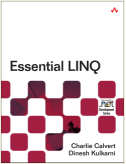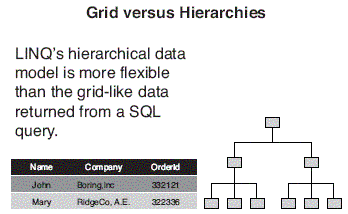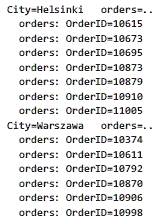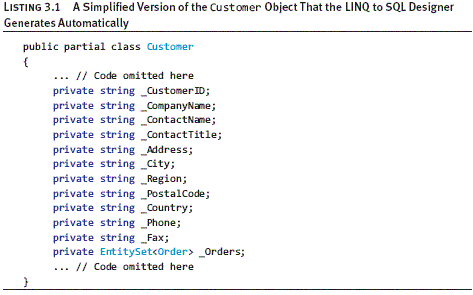
|
Chapter 3
The Essence of LINQ
Reproduced from the book
Essential LINQ. Copyrightã 2008, Pearson Education,
Inc., 800 East 96th Street, Indianapolis, IN 46240.
<<Previous
Next>>
|
Hierarchical
Complex relationships can be expressed in a relational database, but the results
of a SQL query can take only one shape: a rectangular grid. LINQ has no such
restrictions. Built into its very foundation is the idea that data is
hierarchical (see Figure 3.2). If you want to, you can write LINQ queries that
return flat, SQL-like datasets, but this is an option, not a necessity.

Consider a simple relational database that has tables called Customers, Orders,
and OrderDetails. It is possible to capture the relationship between these
tables in a SQL database, but you cannot directly depict the relationship in
the results of a single query. Instead, you are forced to show the result as a
join that binds the tables into a single array of columns and rows.
LINQ, on the other hand, can return a set of customer objects,
each of which owns a set of 0-to-n Orders . Each Order
can be associated with a set of OrderDetails . This is a classic
hierarchical relationship that can be perfectly expressed with a set of
objects:
Customer
Orders
OrderDetails
Consider the following simple hierarchical query that captures the relationship
between two objects:

This query asks for the city in which a customer lives and a list of the orders
the person has made. Rather than returning a rectangular dataset as a SQL query
would, this query returns hierarchical data that lists the city associated with
each customer and the ID associated with each order:

This result set is multidimensional, nesting one set of columns and rows inside
another set of columns and rows.
Look again at the query, and notice how we gain access to the Orders table:
orders = from o in c.Orders
The identifier " is an instance of a Customer object. As you will
learn later in the book, LINQ to SQL has tools for automatically
generating Customer objects given the presence of the Customer
table in the database. Here you can see that the Customer object
is not flat; instead, it contains a set of nested Order objects.
Listing 3.1 shows a simplified version of the Customer object that
is automatically generated by the LINQ to SQL designer. Notice how LINQ to SQL
wraps the fields of the Customer table. Later in this book, you will learn how
to automatically generate Customer objects that wrap the fields
of a Customer table.

The first 11 private fields of the Customer object simply
reference the fields of the Customer table in the database. Taken together,
they provide a location to store the data from a single row of the Customer
table. Notice, however, the last item, which is a collection of Order
objects. Because it is bound to the Orders table in a one-to-many relationship,
each customer has from 0-to-n orders associated with it, and LINQ to SQL stores
those orders in this field. This automatically gives you a hierarchical view of
your data.
The same thing is true of the Order table, only it shows not a one-tomany
relationship with the Customer table, but a one-to-one relationship:

Again we see all the fields of the Orders table, their types, and whether they
can be set to Null. The difference here is that the last field points back to
the Customer table not with an EntitySet<T>, but an EntityRef
<T>. This is not the proper place to delve into the EntitySet
and EntityRef classes. However, it should be obvious to you
that an EntitySet refers to a set of objects, and an EntityRef
references a single object. Thus, an EntitySet captures a
one-to-many relationship, and an EntityRef captures a
one-toone relationship.
The point to take away from this discussion is that LINQ to SQL captures not a
flat view of your data, but a hierarchical view. A Customer class
is connected to a set of orders in a clearly defined hierarchical relationship,
and each order is related to the customer who owns it. LINQ gives you a
hierarchical view of your data.
In a simple case like this, such a hierarchical relationship has obvious
utility, but it is possible to imagine getting along without it. More complex
queries, however, are obviously greatly simplified by this architecture.
Consider the following LINQ to SQL query:

The next line really helps show the power of LINQ hierarchies:
where x.Product.Category.CategoryName == "Confections"
The identifier = represents an instance of a class containing the data from a
row of the Order_Details table. Order_Details has a relationship with the
Product table, which has a relationship with the Category table, which has a
field called CategoryName . We can slice right through that
complex relationship by simply writing this:
x.Product.Category.CategoryName
LINQ’s hierarchical structure shines a clarifying light on the relational data
in your programs. Even complex relational models become intuitive and easy to
manipulate.
We can then order and group the results of our query with a few simple LINQ
operators:

Trying to write the equivalent code using a more conventional C# style of
programming is an exercise that might take two or three pages of convoluted
code and involve a number of nested loops and if statements. Even
writing the same query in standard SQL would be a challenge for many
developers. Here we perform the whole operation in nine easy-to-read lines of
code.
In this section, I have introduced you to the power of LINQ’s hierarchical style
of programming without delving into the details of how such queries work. Later
in this book you will learn how easy it is to compose your own hierarchical
queries. For now you only need to understand two simple points:
• There is a big difference between LINQ’s hierarchical structure and the flat,
rectangular columns and rows returned by an SQL query.
• Many benefits arise from this more powerful structure. These include the
intuitive structure of the data and the ease with which you can write queries
against this model.
<<Previous
Next>>
Also read
Explain the concepts and capabilities of Aspect-Oriented Programming, AOP.
What is Aspect in AOP?
AOP approach addresses Crosscutting concerns. Explain
The components of AOP are advices/interceptors, introductions, metadata, and
pointcuts. Explain them
AOP vs OOPs...........
|